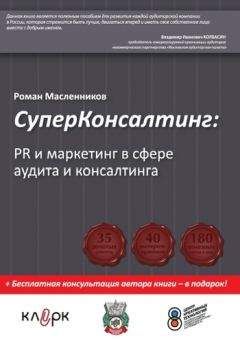Томас Лис - Психология переговоров. Как добиться большего
144
Van Baaren R. B., Holland R. W., Steenaert B., Van Knippenberg A. Mimicry for Money: Behavioral Consequences of Imitation // Journal of Experimental Social Psychology. – 2003. – № 39(4). – P. 393–398.
145
Lakin J. L., Chartrand T. L. Using Nonconscious Behavioral Mimicry to Create Affiliation and Rapport // Psychological Science. – 2003. – № 14(4). – P. 334–339; Van Baaren R. B., Maddux W. W., Chartrand T. L., De Bouter C., Van Knippenberg A. It Takes Two to Mimic: Behavioral Consequences of Self-Construals // Journal of Personality and Social Psychology. – 2003. – № 84(5). – P. 1093; Chartrand T. L., Bargh J. A. The Chameleon Effect: The Perception-Behavior Link and Social Interaction // Journal of Personality and Social Psychology. – 1999. – № 76(6), – P. 893; Cheng C. M., Chartrand T. L. Self-Monitoring without Awareness: Using Mimicry as a Nonconscious Affiliation Strategy // Journal of Personality and Social Psychology. – 2003. – № 85(6). – P. 1170.
146
Yee N., Bailenson J. N., Urbanek M., Chang F., Merget D. The Unbearable Likeness of Being Digital: The Persistence of Nonverbal Social Norms in Online Virtual Environments // CyberPsychology and Behavior. – 2007. – № 10(1). – P. 115–121; Blascovich J., Loomis J., Beall A. C., Swinth K. R., Hoyt C. L., Bailenson J. N. Immersive Virtual Environment Technology as a Methodological Tool for Social Psychology // Psychological Inquiry. – 2002. – № 13(2). – P. 103–124.
147
Maddux W., Mullen E., Galinksy A. Chameleons Bake Bigger Pies and Take Bigger Pieces: Strategic Behavioral Mimicry Facilitates Negotiation Outcomes // Journal of Experimental Social Psychology. – 2008. – № 44. – P. 461–468.
148
Wiltermuth S. S., Neale M. A. Master of the Universe versus the Chameleon: Comparing the Effects of Complementarity and Mimicry in Negotiation Behavior. – Working paper, Stanford Graduate School of Business, Stanford, CA, 2008.
149
Chartrand T. L., Maddux W. W., Lakin J. L. Beyond the Perception-Behavior Link: The Ubiquitous Utility and Motivational Moderators of Nonconscious Mimicry // Unintended Thought 2: The New Unconscious / R. Hassin, J. Uleman, J. A. Bargh (Eds.). – New York: Oxford University Press, 2005. – P. 334–361.
150
LaFrance M. Nonverbal Synchrony and Rapport: Analysis by the Cross-Lag Panel Technique // Social Psychology Quarterly. – 1979. – № 42. – P. 66–70.
151
Цит. по: Maddux W., Mullen E., Galinksy A.
152
Lerner J. S. Tiedens L. Z. Portrait of the Angry Decision Maker: How Appraisal Tendencies Shape Anger’s Influence on Cognition // Journal of Behavioral Decision Making. – 2006. – № 19(2). – P. 115–137; Frijda N. H., Kuipers P., Ter Schure E. Relations among Emotion, Appraisal, and Emotional Action Readiness // Journal of Personality and Social Psychology. – 1989. – № 57(2). – P. 212.
153
Подробнее см.: Harmon-Jones Eddie. Clarifying the Emotive Functions of Asymmetrical Frontal Cortical Activity // Psychophysiology. – 2003. – № 40(6). – P. 838–848; Harmon-Jones E., Segilman J. State Anger and Prefrontal Brain Activity: Evidence That Insult-Related Relative Left-Prefrontal Activation Is Associated with Experienced Anger and Aggression // Journal of Personality and Social Psychology. – 2001. – № 80. – P. 797–803.
154
Lerner J. S., Keltner D. Beyond Valence: Toward a Model of Emotion-Specific Influences on Judgment and Choice // Cognition and Emotion. – 2000. – № 14(4). – P. 473–493.
155
Lerner J. S., Keltner D. Fear, Anger, and Risk // Journal of Personality and Social Psychology. – 2001. – № 81(1). – P. 146.
156
Bodenhausen G. V., Sheppard L. A., Kramer G. P. Negative Affect and Social Judgment: The Differential Impact of Anger and Sadness // European Journal of Social Psychology. – 1994. – 24(1). – P. 45–62; Lerner J. S., Goldberg J. H., Tetlock P. E. Sober Second Thought: The Effects of Accountability, Anger, and Authoritarianism on Attributions of Responsibility // Personality and Social Psychology Bulletin. – 1998. – № 24(6). – P. 563–574; Small D. A., Lerner J. S. Emotional Politics: Personal Sadness and Anger Shape Public Welfare Preferences». – Paper presented at the Society for Personality and Social Psychology, New Orleans, 2005; Tiedens L. Z. Anger and Advancement versus Sadness and Subjugation: The Effect of Negative Emotion Expressions on Social Status Conferral // Journal of Personality and Social Psychology. – 2001. – № 80(1). – P. 86; Tiedens L. Z., Linton S. Judgment under Emotional Certainty and Uncertainty: The Effects of Specific Emotions on Information Processing // Journal of Personality and Social Psychology. – 2001. – № 81(6). – P. 973.
157
Siegman A. W., Smith T. W. (Eds). Anger, Hostility, and the Heart. – London: Psychology Press, 2013.
158
Fragale A. R. The Power of Powerless Speech: The Effects of Speech Style and Task Interdependence on Status Conferral // Organizational Behavior and Human Decision Processes. – 2006. – № 101(2). – P. 243–261.
159
Brescoll V. L., Uhlmann E. L. Can an Angry Woman Get Ahead? Status Conferral, Gender, and Expression of Emotion in the Workplace // Psychological Science. – 2008. – № 19(3). – P. 268–275.
160
Overbeck J. R., Neale M. A., Govan C. L. I Feel, Therefore You Act: Intrapersonal and Interpersonal Effects of Emotion on Negotiation as a Function of Social Power // Organizational Behavior and Human Decision Processes. – 2010. – № 112(2). – P. 126–139.
161
Sondak Harris, Neale Margaret A., Mannix Elizabeth A. Managing Uncertainty in Multiparty Negotiations // Handbook on Negotiation / W. Adair, M. Olekalns (Eds.). – North Hampton, MA: Edward Elgar, 2013. – P. 283–310.
162
Wildschut T., Pinter B., Vevea J. L., Insko C. A., Schopler J. Beyond the Group Mind: A Quantitative Review of the Interindividual Inter-group Discontinuity Effect // Psychological Bulletin. – 2003. – № 129. – P. 698–722.
163
Подробнее см.: Mannix Elizabeth A., Neale Margaret A. What Differences Make a Difference? The Promise and Reality of Diverse Teams in Organizations // Psychological Science in the Public Interest. – 2005. – № 6. – P. 31–55.
164
Turner J. C. The Analysis of Social Influence // Rediscovering the Social Group: A Self-Categorization Theory / J. C. Turner, M. A. Hogg, P. J. Oakes, S. D. Reicher, M. S. Wetherell (Eds.). – Oxford: Blackwell, 1987. – P. 68–88; Allen V. L., Wilder D. A. Group Categorization and Attribution of Belief Similarity // Small Group Behavior. – 1979. – № 10. – P. 73–80.
165
Janis I. Groupthink: Psychological Studies of Policy Decisions and Fiascoes. – New York: Houghton-Mifflin, 1982.
166
Phillips K. W., Northcraft G., Neale M. Surface-Level Diversity and Information Sharing: When Does Deep-Level Similarity Help? // Group Processes and Intergroup Relations. – 2006. – № 9. – P. 467–482.
167
Phillips K. W. The Effects of Categorically Based Expectations on Minority Influence: The Importance of Congruence // Society for Personality and Social Psychology. – 2003. – № 29. – P. 3–13; Phillips K. W., Loyd D. L. When Surface and Deep Level Diversity Meet: The Effects of Dissenting Group Members // Organizational Behavior and Human Decision Processes. – 2006. – № 99. – P. 143–160.
168
Phillips K. Y., Apfelbaum E. Delusions of Homogeneity: Reinterpreting the Effects of Group Diversity // Research on Managing Groups and Teams, vol. 16: Looking Back, Moving Forward / M. A. Neale, E. A. Mannix (Eds.). – Bringley, UK: Emerald, 2012. – P. 185–207.
169
Phillips K. W., Loyd D. L. When Surface and Deep Level Diversity Meet: The Effects of Dissenting Group Members // Organizational Behavior and Human Decision Processes. – 2006. – № 99. – P. 143–160.
170
Loyd D. L., Wang C. S., Phillips K. W., Lount R. L. Social Category Diversity Promotes Pre-Meeting Elaboration: The Role of Relationship Focus // Organization Science. (В печати.)
171
Cao J., Phillips K. W. Team Diversity and Information Acquisition: How Homogeneous Teams Set Themselves Up to Have Less Conflict. – Working paper, Columbia Business School, 2013.
172
Halevey N. Team Negotiation: Social, Epistemic, Economic, and Psychological Consequences of Subgroup Conflict // Personality and Social Psychology Bulletin. – 2008. – № 34. – P. 1687–1702.
173
Borenstein G. Intergroup Conflict: Individual, Group, and Collective Interests // Personality and Social Psychology Review. – 2003. – № 7. – P. 129–145.
174
Brewer M. B. In-Group Bias in the Minimal Intergroup Situation: A Cognitive-Motivational Analysis // Psychological Bulletin. – 1979. – № 86. – P. 307–324.




